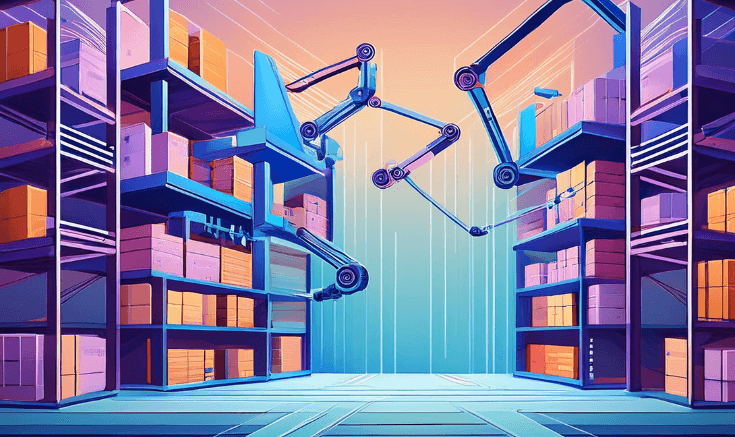

7 benefits of robotic process automation in supply chain
JAN. 3, 2025
5 Min Read
Supply chain operations perform best on precision and efficiency, yet the complexity of global logistics often leaves gaps that slow progress and inflate costs.
Robotic process automation delivers a smarter way to address these challenges, transforming routine tasks into seamless, efficient workflows. Businesses that embrace this technology unlock opportunities to streamline operations, reduce costs, and deliver exceptional value to their customers.
Key takeaways
- 1. Automating repetitive tasks with RPA reduces costs and minimizes errors in supply chain management.
- 2. Enhanced accuracy and efficiency improve data reliability, enabling better decision-making and forecasting.
- 3. Streamlining workflows through RPA elevates productivity and scalability for growing businesses.
- 4. Customer satisfaction improves through faster processing times and more transparent communication.
- 5. Measuring RPA's impact through metrics like cost savings and operational speed ensures ongoing optimization.
What is robotic process automation in supply chain?
 Robotic process automation in supply chain refers to the application of software tools to automate repetitive, rule-based tasks across various stages of supply chain management. These tasks, often labor-intensive and prone to human error, can include inventory monitoring, order processing, data entry, and shipment tracking. Unlike traditional automation, which focuses on physical or mechanical systems, RPA leverages software bots to interact with digital systems and execute workflows, mimicking human actions such as keystrokes and clicks.
Robotic process automation in supply chain refers to the application of software tools to automate repetitive, rule-based tasks across various stages of supply chain management. These tasks, often labor-intensive and prone to human error, can include inventory monitoring, order processing, data entry, and shipment tracking. Unlike traditional automation, which focuses on physical or mechanical systems, RPA leverages software bots to interact with digital systems and execute workflows, mimicking human actions such as keystrokes and clicks.Supply chain operations often involve a complex network of processes and stakeholders, requiring seamless coordination to meet customer demands efficiently. With RPA, businesses can streamline these operations, minimize manual interventions, and enhance accuracy. For example, automating order updates and invoice processing ensures faster and more accurate service delivery, reducing delays caused by human oversight.
When speed, cost efficiency, and precision are paramount, RPA serves as a valuable tool to enhance performance. By bridging gaps between disconnected systems and eliminating bottlenecks, RPA enables companies to achieve scalable, cost-effective supply chain solutions, unlocking new competitive advantages.
"Robotic process automation in supply chain replaces manual processes with intelligent automation that ensures accuracy, scalability, and improved operational outcomes."
7 benefits of RPA in supply chain
Robotic process automation in supply chain operations delivers transformative value by addressing critical inefficiencies and enhancing performance across every stage of the supply chain. Supply chain management often involves repetitive and time-sensitive tasks that demand precision and speed, yet they are also prone to human error. RPA technology steps in as a solution, replacing manual processes with intelligent automation that ensures accuracy, scalability, and improved operational outcomes.
From managing inventory to streamlining order fulfillment, the application of RPA enables businesses to reduce costs, improve accuracy, and elevate overall productivity. Organizations across industries are quickly adopting this technology to meet the demands of modern logistics and gain an innovative edge. When handling large-scale operations or managing fluctuating demands, RPA empowers companies to align resources efficiently, achieve higher customer satisfaction, and scale seamlessly in response to growth opportunities.
1. Cost reduction
 Implementing RPA significantly cuts costs by automating repetitive tasks, reducing the need for manual labor. For example, automating data entry processes can save companies from hiring additional staff or overburdening existing teams with low-value tasks. Software bots operate 24/7 without interruptions, ensuring consistency and efficiency, which minimizes costly errors and delays.
Implementing RPA significantly cuts costs by automating repetitive tasks, reducing the need for manual labor. For example, automating data entry processes can save companies from hiring additional staff or overburdening existing teams with low-value tasks. Software bots operate 24/7 without interruptions, ensuring consistency and efficiency, which minimizes costly errors and delays.Reallocating resources from manual tasks to more strategic activities allows businesses to prioritize growth areas. This results in tangible financial savings, especially in high-volume supply chain environments where even small inefficiencies can accumulate into substantial costs.
2. Increased accuracy and efficiency
RPA eliminates human error by standardizing processes and maintaining data integrity. Tasks such as updating order statuses, generating invoices, or reconciling inventory data are performed with precision, ensuring accurate records at all times.
With reduced discrepancies, businesses experience fewer disruptions and better compliance with regulatory standards. The efficiency gained allows supply chain managers to make informed decisions based on reliable data, enabling them to adapt swiftly to demands.
3. Enhanced productivity
 Through automation, companies can process more transactions in less time. For instance, bots can handle multiple orders simultaneously, manage supplier communications, and update shipment statuses in real time, freeing employees to focus on problem-solving and strategic planning.
Through automation, companies can process more transactions in less time. For instance, bots can handle multiple orders simultaneously, manage supplier communications, and update shipment statuses in real time, freeing employees to focus on problem-solving and strategic planning.The scalability of RPA ensures that as business operations grow, the technology adapts without requiring significant infrastructure changes. This ability to handle increased workloads seamlessly contributes to higher overall productivity.
4. Improved supply and demand planning
Supply and demand planning relies heavily on accurate and timely data. RPA facilitates the collection, integration, and analysis of data from various sources, including sales forecasts, inventory levels, and market trends.
Automating these tasks provides businesses with a comprehensive view of their operations, enabling them to predict demand fluctuations more accurately and plan accordingly. This proactive approach reduces the risk of overstocking or stockouts, optimizing resource allocation.
5. Better inventory management
 Inventory mismanagement can lead to costly inefficiencies, including excessive storage costs or missed sales opportunities. RPA enhances inventory control by continuously monitoring stock levels, generating alerts for replenishment, and automating reorder processes based on pre-set thresholds.
Inventory mismanagement can lead to costly inefficiencies, including excessive storage costs or missed sales opportunities. RPA enhances inventory control by continuously monitoring stock levels, generating alerts for replenishment, and automating reorder processes based on pre-set thresholds.This automation ensures that inventory levels are aligned with current demand, reducing waste and improving cash flow. The result is a more responsive and resilient supply chain.
6. Streamlined order processing
Processing customer orders quickly and accurately is a cornerstone of effective supply chain management. RPA automates order receipt, validation, and routing, ensuring seamless transitions between stages of the supply chain.
Faster order processing leads to quicker delivery times, which enhances customer satisfaction. Additionally, automation reduces the risk of errors, such as incorrect shipping details, which can be costly to rectify and damage customer relationships.
7. Enhanced customer service
With RPA handling back-office tasks, customer service teams can focus on addressing inquiries and resolving issues promptly. Automation tools can also assist in tracking shipments, updating customers on delivery statuses, and managing returns more efficiently.
This improved responsiveness builds trust and loyalty, setting businesses apart across industry markets. Happy customers are more likely to return and recommend the company, creating a cycle of positive reinforcement.
The integration of RPA into supply chain operations not only solves immediate operational challenges but also unlocks long-term value by enhancing scalability, adaptability, and customer satisfaction. Each benefit outlined above showcases how this technology reshapes traditional logistics into a dynamic and resilient system capable of succeeding. Regardless if the goal is reducing costs, improving service levels, or building a smarter operational framework, RPA provides the tools to meet these objectives with measurable success.
Implementing RPA in the supply chain
Integrating robotic process automation into supply chain management requires a well-structured approach to maximize its potential and align with organizational goals. Successful implementation begins with identifying the specific tasks and processes that can benefit most from automation, ensuring alignment with operational priorities and business objectives. Below is a structured breakdown of the implementation process.
Identifying automation opportunities
The first step involves mapping out supply chain workflows to identify repetitive, rule-based tasks prone to human error or inefficiency. Common areas include order management, inventory tracking, data entry, and invoice processing. Prioritizing high-volume or high-impact tasks ensures that automation delivers measurable returns early in the deployment.
Organizations should conduct a comprehensive audit of current processes, focusing on areas where delays or errors frequently occur. Collaborative discussions with key stakeholders across departments provide valuable insights into operational pain points and areas of improvement.
Selecting the right RPA tools
Choosing the appropriate RPA software is critical to achieving the desired outcomes. Businesses should evaluate tools based on scalability, integration capabilities, and ease of use. Platforms offering robust analytics and real-time monitoring enable teams to track performance and adapt workflows as needed.
Compatibility with existing systems is another key consideration. Ensuring seamless integration prevents disruptions during implementation and enhances the overall efficiency of automated processes.
Building and testing workflows
Before deploying automation across the supply chain, it is important to design and test workflows in a controlled ecosystem. This step ensures that bots perform tasks accurately and as intended. Testing helps identify potential bottlenecks or errors, allowing for adjustments before full-scale implementation.
Involving team members during testing promotes user buy-in and provides an opportunity for feedback. Training sessions can also familiarize employees with the new system, reducing resistance to change.
Monitoring and continuous optimization
Post-implementation, ongoing monitoring ensures that automation continues to deliver value. RPA tools often include performance dashboards, providing insights into metrics such as task completion times, error rates, and cost savings.
Regular reviews and updates to workflows ensure alignment with evolving business needs. Scaling automation to additional processes over time amplifies its impact and extends benefits across the entire supply chain. Organizations should also remain open to adopting complementary technologies, such as artificial intelligence, to enhance the capabilities of their RPA systems.
Examples of robotic process automation in supply chain
Robotic process automation in supply chain operations showcases its value across multiple use cases, enabling businesses to reimagine traditional workflows and achieve greater efficiency. The complex nature of supply chains often involves repetitive tasks that demand speed and precision, yet manual handling can introduce delays and errors.
RPA addresses critical challenges in supply chain management, creating seamless integrations between systems and optimizing workflows. Automation not only reduces operational overhead but also equips businesses with the tools to adapt to fluctuating market dynamics.
- Order entry and processing: Automating order receipt and validation reduces manual effort and speeds up processing times. RPA bots extract and validate order details from emails or electronic data interchange (EDI) files, ensuring accurate and timely fulfillment.
- Inventory monitoring and management: RPA tools continuously track inventory levels and generate alerts when thresholds are reached. These alerts trigger automated reordering processes, maintaining optimal stock levels and preventing disruptions.
- Shipment tracking and updates: Automation simplifies the task of tracking shipments and providing real-time updates. RPA bots pull data from carrier systems and send notifications to customers, ensuring transparency and improved service levels.
- Invoice processing and reconciliation: Bots handle tasks such as extracting invoice details, matching them to purchase orders, and flagging discrepancies for review. This streamlines accounts payable workflows and improves accuracy in financial reporting.
- Supplier communication: RPA enhances supplier interactions by automating the exchange of routine information, such as delivery schedules and order confirmations. This ensures consistent communication while freeing up employees to focus on strategic supplier relationships.
- Demand forecasting: Integrating RPA with analytics tools automates the collection and processing of data from multiple sources, enabling precise demand forecasts. This supports better planning and reduces the risk of overproduction or stockouts.
Automation enables businesses to achieve cost savings, reduce manual errors, and scale their operations with confidence. Integrating RPA into supply chain processes builds a strong foundation for resilience, ensuring that companies can maintain top performance in dynamic market conditions. Whether addressing specific inefficiencies or enhancing end-to-end workflows, RPA creates value that resonates throughout the entire supply chain ecosystem.
"RPA simplifies the task of tracking shipments and providing real-time updates, ensuring transparency and improved service levels."
Measuring the business impact of robotic process automation in the supply chain
 The impact of robotic process automation in supply chain operations is best quantified through key performance indicators (KPIs) that align with organizational goals. Cost savings stand out as a primary metric, as automation reduces labor expenses and minimizes errors that can lead to financial losses. Tracking changes in operational efficiency, such as the time required to complete repetitive tasks like order processing or invoice reconciliation, offers clear evidence of RPA’s value. Additionally, businesses can evaluate error rates to determine how well automation improves accuracy in data handling, inventory management, and other critical processes.
The impact of robotic process automation in supply chain operations is best quantified through key performance indicators (KPIs) that align with organizational goals. Cost savings stand out as a primary metric, as automation reduces labor expenses and minimizes errors that can lead to financial losses. Tracking changes in operational efficiency, such as the time required to complete repetitive tasks like order processing or invoice reconciliation, offers clear evidence of RPA’s value. Additionally, businesses can evaluate error rates to determine how well automation improves accuracy in data handling, inventory management, and other critical processes.Customer satisfaction provides another vital measure of RPA’s effectiveness, reflecting improvements in service speed, order accuracy, and communication transparency. Scalability metrics further assess how well RPA adapts to increased workloads or new workflows, demonstrating its ability to grow alongside business needs. Analyzing these measurable outcomes enables supply chain leaders to refine their strategies, ensuring that automation continues to drive efficiency, reliability, and long-term ROI. This approach reinforces the value of RPA as a powerful tool for maintaining competitive agility.
Streamlining supply chain operations is not just about efficiency—it’s about creating a resilient foundation for sustained growth and innovation. Robotic process automation empowers businesses to reimagine workflows, prioritize strategic goals, and drive impactful results. At Lumenalta, we specialize in building tailored automation solutions that align with your goals, ensuring you’re equipped to excel in a dynamic market.
Let’s light the path to a brighter future together.
table-of-contents
- What is robotic process automation in supply chain?
- 7 benefits of RPA in supply chain
- 1. Cost reduction
- 2. Increased accuracy and efficiency
- 3. Enhanced productivity
- 4. Improved supply and demand planning
- 5. Better inventory management
- 6. Streamlined order processing
- 7. Enhanced customer service
- Implementing RPA in supply chain
- Examples of robotic process automation in supply chain
- Measuring business impact of robotic process automation in supply chain
- Common questions about robotic process automation in supply chain
Common questions about robotic process automation in supply chain
What is robotic process automation in supply chain management?
How does RPA improve supply chain efficiency?
What are the cost benefits of RPA in supply chain management?
Can RPA adapt to changes in supply chain operations?
How does RPA enhance customer service in supply chains?
Want to learn how robotic process automation can bring more transparency and trust to your operations?





